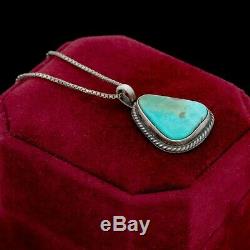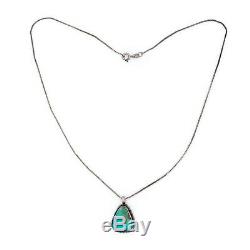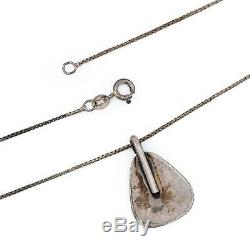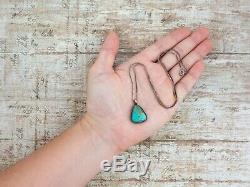
- Vintage Sterling Silver
- Base Metal
- Department
- Metal
- .925 Sterling Silver (3)
- 925 Silver (3)
- 925 Sterling Silver (5)
- Brass (7)
- Fine Silver (10)
- Rose Gold (2)
- Rose Gold Plated (5)
- Silver (330)
- Silver Plated (10)
- Sterling Silver (2878)
- Sterling Silver .925 (2)
- Sterling Silver 925 (5)
- Sterling-silver (3)
- White Gold (2)
- White Gold Plated (30)
- Yellow Gold (7)
- Yellow Gold Plated (26)
- Other (751)
- Shape
- Style
- Vintage
Antique Vintage Sterling Silver Native Navajo Royston Turquoise Pendant Necklace






We have similar Turquoise and Navajo items, which would pair nicely with this piece, for sale this week. Item Description by: Angela A. Age Circa: Antique Native Navajo C. Markings: "925 Italy" on the chain, tested, and guaranteed. Country of Origin: United States, Navajo Nation (pendant); Italy (chain).
Gram Weight: 6.3 grams. Color: opaque bright blue hue with with mottled light tan and lighter blue hues, as well as deeper brown hues.
Stone Treatment: The stone(s) appear to be untreated, but we are not certified gemologists. Stone(s) have been tested and guaranteed using a professional Presidium Duo refractive, heat, and hardness tester. Stone Cuts: Carved and polished cabochon.Chain width: 1.10 mm. Pendant measurements: 1.03" long, 0.68" wide. Bale opening: 4 mm long, 3.11 mm wide.
Closure/Clasp Type: Spring ring clasp and standard bale. Link Type: Box link chain.
Handmade during the 1940s, the Fred Harvey era, by a talented Navajo silversmith. The pendant features a beautiful bright blue Royston turquoise stone from Nevada.
The necklace also showcases a rope twist design adorning the stone's bezel seting. The pendant is strung on a box link chain and completed with a spring ring clasp. When worn, the necklace rests against the decolletage on most people. Tarnish in some areas on the sterling silver gives this piece an antique quality which we believe is quite lovely. This listing is for the item only.
This beautiful piece was made by a very talented Native American silversmith. It features handcrafted silversmith work throughout. Antique Native American jewelry is very rare to find. This is due to these pieces being made for reservation and personal use before the tourist trade became popular.
Very few pieces were made and even less survived to today. The Navajo Nation sits on 27,000 square miles within the states of Arizona, New Mexico, and Utah. The Navajo have a rich history and culture and have become known for creating some of the finest sterling silver and turquoise jewelry, incorporating their own traditional motifs with silversmithing.
The squash blossom necklace is perhaps one the most famous Navajo styles produced, along with turquoise inlay rings. Turquoise is an important stone in Navajo culture; symbolizing happiness, good fortune, and good health. The first Navajo silversmith, Atsidi Sani, was taught around 1865 by a Mexican silversmith.
Atsidi Sani, in turn, taught his four sons, who then started teaching other Navajo artisans. In the beginning, Navajo artisans created sterling silver jewelry for themselves and others in the Navajo Nation. The concept of Pawn, Old Pawn, and Dead Pawn Native American Jewelry came to be in the 1800s.
When a loan wasnt repaid, the item became known as either Old Pawn or Dead Pawn. Turquoise is found all over the world and has been a popular semi-precious stone used in jewelry and art for thousands of years by many different cultures; from prehistoric times to the present. Turquoise comes in many beautiful color variations; from the popular bright solid sky-blue hues to dark blue hues with dark spiderwebbing throughout, as well as aqua, teal, and many green varieties, and even some rare white with dark spiderwebbing. Royston turquoise is a Nevada turquoise famous for being one of the few naturally green forms of turquoise in the world. It ranges in color from rich forest green and aqua blue offset by a heavy golden-brown matrix. Occasionally true-blue turquoise is found, along with spiderweb turquoise varieties. The item "Antique Vintage Sterling Silver Native Navajo Royston Turquoise Pendant Necklace" is in sale since Saturday, August 22, 2020. This item is in the category "Jewelry & Watches\Ethnic, Regional & Tribal\Native American\Necklaces & Pendants". The seller is "abeautifultimeco" and is located in Fort Collins, Colorado. This item can be shipped worldwide.- Country of Origin: United States, Navajo Nation
- Modified Item: No
- Country/Region of Manufacture: United States
- Ethnic Origin: Navajo
- Metal Purity: .925
- Main Stone: Turquoise
- Metal: Sterling Silver
- Jewelry Type: Necklaces
- Tribal Affiliation: Navajo

